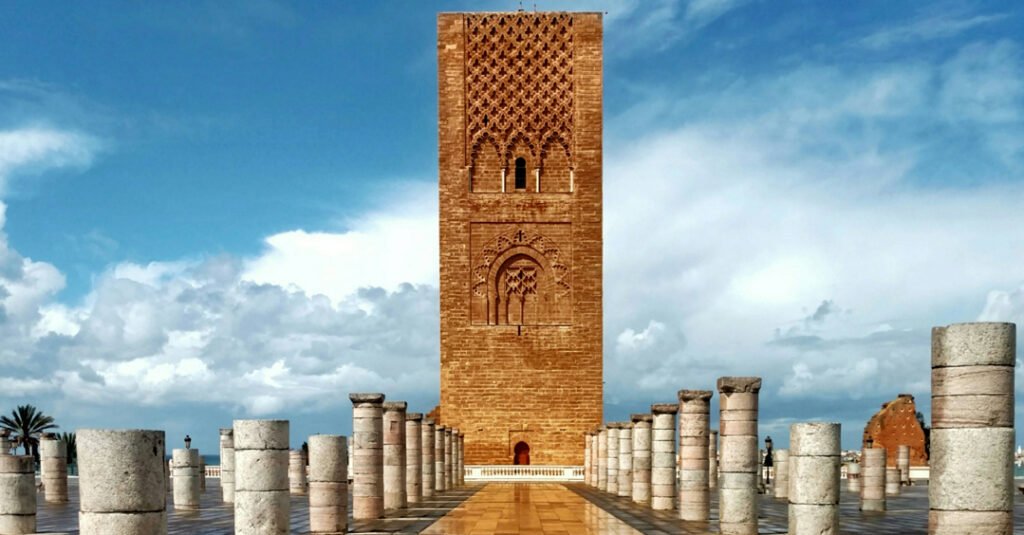Hassan Tower in Rabat stands as a majestic symbol of Morocco’s rich history and architectural grandeur. Located in the heart of Rabat, this iconic tower is a testament to the ambitions of the Almohad dynasty and remains one of the city’s most important tourist attractions. In this article, we explore the fascinating history of Hassan Tower in Rabat, its unique Almohad architecture, the unfinished mosque it was part of, and practical tips for visitors to this historic site.

History of Hassan Tower: The Dream of a Grand Project
The history of Hassan Tower’s construction dates back to the Almohad dynasty period, specifically to the late 12th century, when Rabat (then known as Ribat al-Fath) was becoming the new capital of this powerful dynasty whose influence extended across North Africa and Andalusia.
Sultan Yacoub al-Mansour: The Initiator of the Mosque and Tower
The Almohad Sultan Abu Yusuf Yacoub al-Mansour was the mastermind behind the Hassan Tower project. In 1195, Yacoub al-Mansour ordered the construction of a massive mosque worthy of his new capital’s status, with the ambition for it to become one of the largest mosques in the Islamic world. Hassan Tower was to be the minaret of this great mosque, rising proudly to proclaim the power and grandeur of the Almohad dynasty.
Beginning of Construction and Intended Objectives
The construction of Hassan Tower and the surrounding mosque began around 1195, with the goal of creating a huge mosque capable of accommodating tens of thousands of worshippers. The project was extremely ambitious in its size and design, inspired by Almohad architectural achievements in other regions such as the Koutoubia Mosque in Marrakech and the Giralda in Seville.
Construction Halt: The Death of Sultan Yacoub al-Mansour
Hassan Tower and the surrounding mosque were never completed as planned. Construction abruptly stopped in 1199 after the death of Sultan Yacoub al-Mansour, leaving the project halfway done. The tower reached only 44 meters instead of the planned 86 meters, and all that remained of the mosque were its foundations and columns, testifying to a great unfinished project.
Architecture of Hassan Tower: Authentic Almohad Art
Hassan Tower is a remarkable example of Almohad-Andalusian architectural style, with its square design and unique decorations that reflect the craftsmanship of engineers and artisans of this historical period.
Tower Design and Dimensions
Hassan Tower is distinguished by its square base of approximately 16 meters by 16 meters. Its current height is about 44 meters, but the original design aimed for a height of approximately 86 meters, similar to that of the Giralda in Seville, also built by the Almohads. The tower is composed of several progressively rising levels, and its façades are characterized by arched windows and meticulous architectural engravings.
Interior Ramps Instead of Stairs
One of the most interesting architectural features of Hassan Tower is its internal access system. Instead of traditional stairs, the tower was designed with internal spiral ramps allowing the muezzin to ascend on horseback to the top of the minaret. This unique design reflects the attention to practical details as well as architectural beauty in Almohad art.
Building Materials and Decorations
Hassan Tower was built with reddish-orange sandstone, giving it a distinctive color, particularly at sunrise and sunset. Each of the tower’s four façades displays different and elaborate geometric decorations reflecting the authentic Almohad style. The façades feature interlacing arches and the characteristic “sebka” pattern, which is a network of interwoven arches. It is noteworthy that each side of the tower carries a different decorative design, reflecting the diversity and richness of Almohad architectural art.
The Hassan Mosque Complex: What Remains of the Grand Project
Hassan Tower is only part of an immense mosque project that would have been the largest in North Africa had its construction been completed. Today, the tower stands alone in the middle of a vast esplanade containing the remains of this ambitious project.
Remains of the Mosque: Columns and Ground
When visiting the Hassan Tower complex, you will notice hundreds of columns aligned in regular rows around the tower. These columns are all that remain of the immense prayer hall that was planned. They extend over a vast area of approximately 180 × 140 meters, giving visitors an idea of the colossal size of the mosque that was to be built.
By observing the arrangement and extent of the columns, one can imagine what the mosque would have looked like if it had been completed. The prayer hall was to be of the “hypostyle” type, characterized by a vast space divided by rows of columns supporting the roof. If this project had been completed, it would have been one of the largest mosques in the world at that time.
The Mohammed V Mausoleum: An Important Adjacent Monument
On the same esplanade where Hassan Tower stands, rises another equally important and more modern monument, the Mohammed V Mausoleum, which represents a link between Morocco’s ancient and modern history.
The Mohammed V Mausoleum, completed in 1971, is located in the southern part of the Hassan Mosque site. The location of the mausoleum is not random; it was carefully chosen to connect the symbol of modern Morocco (King Mohammed V) to the symbol of Morocco’s historical glory (Hassan Tower and the Almohad dynasty).
The mausoleum houses the remains of King Mohammed V and his sons, King Hassan II and Prince Abdallah. The architecture of the mausoleum is characterized by a magnificent blend of modern Moroccan architecture while preserving authentic artistic traditions. The mausoleum is decorated with zellige (Moroccan mosaic), carved plaster, cedar wood, and marble, reflecting the continuity of traditional Moroccan crafts in the modern era.
The mausoleum is guarded by an honor guard in traditional costumes, some on foot and others on horseback, giving the place a solemn atmosphere. Visitors, including non-Muslims, can visit the interior of the mausoleum and see the tombs from an upper gallery, respecting the etiquette of the visit such as wearing decent clothing and maintaining calm inside the mausoleum.
The Historical and Cultural Importance of Hassan Tower
The importance of Hassan Tower goes beyond its beauty as a tourist site. It represents:
- A symbol of the power and ambition of the Almohad dynasty whose influence extended across North Africa and southern Europe.
- A remarkable example of Moroccan-Andalusian architecture that blends Moroccan and Andalusian architectural traditions.
- A link between Rabat’s glorious past and its modern role as the capital of the Kingdom of Morocco, particularly with the presence of the adjacent Mohammed V Mausoleum.
- Part of a UNESCO World Heritage site as part of “Rabat, Modern Capital and Historic City”.
Visiting Hassan Tower and the Surrounding Complex: Practical Guide
The Hassan Tower and Mohammed V Mausoleum complex is one of the most visited places in Rabat. Here is a guide to help you explore the site in the best possible way.
Location
The Hassan Tower complex is located in the heart of Rabat, near the Bouregreg River and the old city walls. It is easily accessible on foot from the city center or by taxi from any point in Rabat.
Access to the Hassan Tower Site
Visitors can access the Hassan Tower esplanade for free and examine the columns and areas surrounding the tower. The site is open all day, but it is best to visit during daylight hours to enjoy the beauty of the architecture and see the details clearly.
Visiting the Mohammed V Mausoleum
The Mohammed V Mausoleum is open to visitors, including non-Muslims. Visitors can see the tombs from an upper gallery that surrounds the main hall. To visit the mausoleum, please respect:
- Wear decent clothing covering shoulders and knees
- Maintain calm and silence inside the mausoleum
- Respect all instructions from the guards
- Do not use flash when taking photos
What to See at the Site
During your visit to the Hassan Tower complex, be sure to see:
- Hassan Tower itself from all angles, note the different decorations on each façade
- The field of columns extending around the tower
- The magnificent view of the Bouregreg River and the neighboring city of Salé
- The Mohammed V Mausoleum with its amazing interior decorations
- The honor guard in front of the mausoleum, and particularly the changing of the guard if you are lucky
Best Time to Visit
It is best to visit the complex early in the morning or before sunset, to avoid the heat of the day and enjoy the beauty of the golden light on the tower. Sunset also offers spectacular views of the tower with the river in the background.
Duration of the Visit
A complete visit to the Hassan Tower complex and the Mohammed V Mausoleum takes about an hour to an hour and a half. Take your time to explore the different angles, take photos, and appreciate the place and its historical importance.
Conclusion: Hassan Tower, Symbol of Rabat’s History and Modernity
Hassan Tower and the Mohammed V Mausoleum represent the most important historical complex in Rabat. They combine the ambition of the glorious past embodied in Sultan Yacoub al-Mansour’s project, and the present of contemporary Morocco embodied in the mausoleum of King Mohammed V, founder of modern Morocco.
During your visit to Rabat, don’t miss the opportunity to explore this unique monument that tells the story of a civilization and culture extending through time. Take your souvenir photos, enjoy the magnificent views, and share your experience with others.
Have you already visited Hassan Tower? Share your experience and photos in the comments below. And if you’re planning to visit Rabat, don’t hesitate to ask your questions about this magnificent monument and we’ll help you plan your trip.





Leave a reply